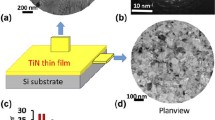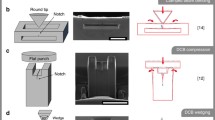Abstract
A novel load–displacement sensing instrument has been designed and fabricated to characterize the fracture properties of brittle thin films at low temperature (approximately −30 °C) and pressure (1.6e-4 Pa) environments. In this study, the instrument was used to investigate the effects of harsh environments on the fracture behaviors of organosilicate glass (OSG) and silicon carbonitride (SiCN) thin films under four-point bend loading. Experimental results showed that the fracture strengths of film stacks are the highest when the environment contains a very low water molecule concentration. This condition can be achieved by purging the testing chamber with pure nitrogen or reducing the chamber pressure to less than 1 Pa. In contrast, cracks propagated readily along OSG/SiCN interfaces when experiments were performed in deionized water. The effects of low temperature (approximately −30 °C) and pressure on thin film fracture were also studied, and the results demonstrated that there is no observed degradation of the OSG fracture properties. X-ray photoelectron spectroscopy (XPS) technique was used to identify the chemical composition of the fracture surfaces.













Similar content being viewed by others
References
M.L. O’Neill, M.K. Haas, B.K. Peterson, R.N. Vrtis, S.J. Weigel, D. Wu, M.D. Bitner, and E.J. Karwacki: Impact of pore size and morphology of porous organosilicate glasses on integrated circuit manufacturing, in Technology and Reliability of Low-k Dielectrics and Copper Interconnects, edited by T.Y. Tsui, Y.C. Joo, L. Michaelson, M. Lane, and A.A. Volinsky (Mater. Res. Soc. Symp. Proc., Vol. 914, Materials Research Society, Warrendale, PA, 2006), pp. 3–14.
K. Maex, M.R. Baklanov, D. Shamiryan, F. Iacopi, S.H. Brongersma, and Z.S. Yanovitskaya: Low-dielectric constant materials for microelectronics. J. Appl. Phys. 93, 8793 (2003).
M. Morgen, E.T. Ryan, J.H. Zhao, C. Hu, T. Cho, and P.S. Ho: Low-dielectric constant materials for ULSI interconnects. Annu. Rev. Mater. Sci. 30, 645 (2000).
E.G. Liniger and R.F. Cook: A controlled flaw technique for lifetime characterization. J. Am. Ceram. Soc. 76, 2123 (1993).
B.R. Lawn: Diffusion-controlled subcritical crack growth in the presence of a dilute gas environment. Mater. Sci. Eng. 13, 277 (1974).
S.M. Wiederhorn: Influence of water vapor on crack propagation in soda-lime glass. J. Am. Ceram. Soc. 50, 407 (1967).
S.M. Wiederhorn and L.H. Bolz: Stress corrosion and static fatigue of glass. J. Am. Ceram. Soc. 53, 543 (1970).
S.M. Wiederhorn and H. Johnson: Effect of electrolyte pH on crack propagation in glass. J. Am. Ceram. Soc. 56, 192 (1973).
S.M. Wiederhorn, E.R. Fuller, and R. Thomson: Micromechanisms of crack growth in ceramics and glasses in corrosive environments. J. Ment. Sci. 14, 450 (1980).
B.R. Lawn: An atomistic model of kinetic crack growth. J. Mater. Sci. 10, 469 (1975).
R.F. Cook and E.G. Liniger: Stress-corrosion cracking of low-dielectric constant spin-on-glass thin films. J. Electromech. Soc. 146, 4439 (1999).
S.Y. Kook and R.H. Dauskardt: Moisture-assisted subcritical debonding of a polymer/metal interface. J. Appl. Phys. 91, 1293 (2002).
M. Lane, R. Dauskardt, Q. Ma, H. Fujimoto, and N. Krishna: Subcritical debonding of multilayer interconnect structures: Temperature and humidity effects, in Materials Realibility in Microelectronics IX, edited by C.A. Volkert, A.H. Verbruggen, and D.D. Brown (Mater. Res. Soc. Symp. Proc., Vol. 563, Warrendale, PA, 1999), pp. 251–256.
M.W. Lane, J.M. Snodgrass, and R.H. Dauskardt: Environmental effects on interfacial adhesion. Microelectron. Reliab. 41, 1615 (2001).
J.W. Hutchinson and Z. Suo: Mixed mode cracking in layered materials. Adv. Appl. Mech. 29, 63 (1992).
X.H. Liu, Z. Suo, Q. Ma, and H. Fujimoto: Developing design rules to avert cracking and debonding in integrated circuit structures. Eng. Fract. Mech. 66, 387 (2000).
J.M. Ambrico, E.E. Jones, and M.R. Begley: Cracking in thin multi-layers with finite-width and periodic architectures. Int. J. Solids Struct. 39, 1443 (2002).
X.H. Liu, T.M. Shaw, M.W. Lane, R.R. Rosenberg, S.L. Lane, J.P. Doyle, D. Restaino, S.F. Vogt, and D.C. Edelstein: Channel cracking in low-k films on patterned multi-layers, in Interconnect Technology Conference, June 7–9, 2004, Proceedings of the IEEE 2004 International, pp. 93–95 (2004).
J.J. Vlassak: Channel cracking in thin films on substrates of finite thickness. Int. J. Fract. 119, 299 (2003).
J.J. Vlassak, Y. Lin, and T.Y. Tsui: Fracture of organosilicate glass thin films: Environmental effects. Mater. Sci. Eng., A 391, 159 (2005).
E.P. Guyer, M. Patz, and R.H. Dauskardt: Fracture of nanoporous methyl silsesquioxane thin-film glasses. J. Mater. Res. 21, 882 (2006).
Y. Lin, T.Y. Tsui, and J.J. Vlassak: Water diffusion and fracture in organosilicate glass film stacks. Acta Mater. 55, 2455 (2007).
H. Li, Y. Lin, T.Y. Tsui, and J.J. Vlassak: The effect of porogen loading on the stiffness and fracture energy of brittle organosilicates. J. Mater. Res. 24, 107 (2009).
Y. Lin, Y. Xiang, T.Y. Tsui, and J.J. Vlassak: PECVD low-permittivity organosilicate glass coatings: Adhesion, fracture, and mechanical properties. Acta Mater. 56, 4932 (2008).
D.A. Maidenberg, W. Volksen, R.D. Miller, and R.H. Dauskardt: Toughening of nanoporous glasses using porogen residuals. Nat. Mater. 3, 464 (2004).
F. Iacopi, Y. Tavaly, B. Eyckens, C. Waldfried, T. Abell, E.P. Guyer, D.M. Gage, R.H. Dauskardt, T. Sajavaara, K. Houthoofd, P. Grobet, P. Jacobs, and K. Maex: Short-ranged structural rearrangement and enhancement of mechanical properties of organosilicate glasses induced by ultraviolet radiation. J. Appl. Phys. 99, 053511 (2006).
R.S. Smith, T.Y. Tsui, and P.S. Ho: Effects of ultraviolet radiation on ultra-low-dielectric constant thin film fracture properties. J. Mater. Res. 24(9), 2795 (2008).
C.C. Merrill and P.S. Ho: Effect of mode-mixity and porosity on interfacial fracture of low-k dielectrics, in Technology and Reliability for Advanced Interconnects and Low-k Dielectrics, edited by R.J. Carter, C.S. HauRiege, T.M. Lu, and S.E. Schulz (Mater. Res. Soc. Symp. Proc., Vol. 812, Warrendale, PA, 2004), pp. 61–66.
T.Y. Tsui, A.J. McKerrow, and J.J. Vlassak: The effect of water diffusion on the adhesion of organosilicate glass film stacks. J. Mech. Phys. Solids 54, 887 (2006).
E.P. Guyer and R.H. Dauskardt: Effects of solution pH on the accelerated cracking of nanoporous thin-film glasses. J. Mater. Res. 20, 680 (2005).
Y. Lin, J.J. Vlassak, T.Y. Tsui, and A.J. McKerrow: Environmental effects on subcritical delamination of dielectric and metal films from organosilicate glass (OSG) thin films, in Materials, Technology, and Reliability for Advanced Interconnects and Low-k Dielectrics, edited by A.J. McKerrow, J. Leu, and O. Kraft (Mater. Res. Soc. Symp. Proc., Vol. 766, Warrendale, PA, 2003), pp. 171–176.
P.P.L Matos, R.M. McMeeking, P.G. Charalambides, and M.D. Drory: A method for calculating stress intensities in bimaterial fracture. Int. J. Fract. 40, 235 (1989).
P.G. Charalambides, H.C. Cao, J. Lund, and A.G. Evans: Development of a test method for measuring the mixed-mode fracture resistance of bimaterial interfaces. Mech. Mater. 8, 269 (1990).
Q. Ma, H. Fujimoto, P. Flinn, V. Jain, F. Adibi-Rizi, F. Moghadam, and R.H. Dauskardt: Quantitative measurement of interface fracture energy in multi-layer thin film structures, in Materials Reliability in Microelectronics V, edited by W.F. Filter, K. Gadepally, A.L. Greer, A.S. Oates, and R. Rosenberg (Mater. Res. Soc. Symp. Proc., Vol. 391, Warrendale, PA, 1995), pp. 91–96.
Q. Ma: A four-point bending technique for studying subcritical crack growth in thin films and at interfaces. J. Mater. Res. 12, 840 (1997).
H. Steinherz: Handbook of High Vacuum Engineering (Reinhold Publishing Corp., New York, 1963).
Acknowledgments
T.Y. Tsui thanks the Canadian Natural Sciences and Engineering Research Council (NSERC) Discovery, NSERC Research Tools and Instruments, and the Canada Foundation for Innovation for the financial support of this work.
Author information
Authors and Affiliations
Corresponding author
Rights and permissions
About this article
Cite this article
Barakat, S., Lee-Sullivan, P., Vitale, S.A. et al. The effects of low temperature and pressure on the fracture behaviors of organosilicate thin films. Journal of Materials Research 26, 2524–2532 (2011). https://doi.org/10.1557/jmr.2011.253
Received:
Accepted:
Published:
Issue Date:
DOI: https://doi.org/10.1557/jmr.2011.253




